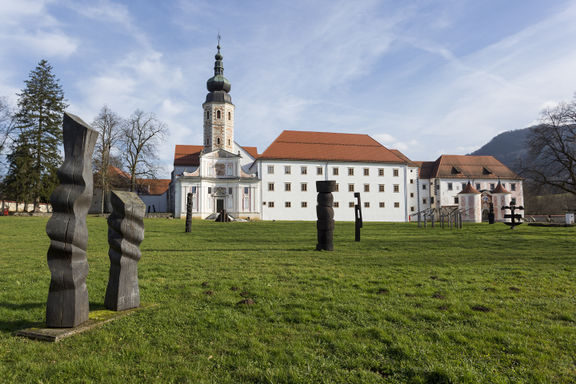Difference between revisions of "Kostanjevica Monastery"
(imported from XML by extractor/importer) |
m (Text replace - "{{Abstract" to "{{Teaser") |
||
| Line 20: | Line 20: | ||
}} | }} | ||
| − | {{ | + | {{Teaser| |
The Cistercian monastery at Kostanjevica na Krki was built on a marshy plain near the Krka River in 1234, initially as a three-nave church with a transversal nave and a flat-ended choir area (Bernardine ground plan). During the 15th century a bell tower was added to the church and the naves were shortened on the west side, supposedly due to the difficulties connected with the bearing capacity of the terrain. During the 17th and 18th centuries the entrance was remodelled, the choir loft was extended and the naves were re-vaulted. Construction of the monastery buildings began in the late 14th century; a hall was added in the 16th century and residential wings with arcades in the 18th century. | The Cistercian monastery at Kostanjevica na Krki was built on a marshy plain near the Krka River in 1234, initially as a three-nave church with a transversal nave and a flat-ended choir area (Bernardine ground plan). During the 15th century a bell tower was added to the church and the naves were shortened on the west side, supposedly due to the difficulties connected with the bearing capacity of the terrain. During the 17th and 18th centuries the entrance was remodelled, the choir loft was extended and the naves were re-vaulted. Construction of the monastery buildings began in the late 14th century; a hall was added in the 16th century and residential wings with arcades in the 18th century. | ||
}} | }} | ||
Revision as of 13:54, 27 November 2009
After the abolition of the monasteries in 1786 the altars and other church fittings were taken away or sold. Thereafter the monastery buildings fell into decay, and were finally burnt down in 1942. Renovation commenced in 1958 and by 1971 the church had been reconstructed by Institute for the Protection of Cultural Heritage of Slovenia (ZVKDS). Today it no longer operates as a monastery but is devoted purely to secular activities.
A selection of wooden sculptures by artists of several nationalities has been displayed in the grounds of the monastery since the Forma Viva exhibition of 1961. The Božidar Jakac Gallery was opened here in 1974.



